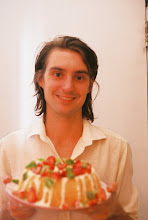I've been feeling quite worthless about my music activities recently. I recorded all of my tapes to digital and have been giving copies of them to my friends. They enjoy the works and I am often asked when my next show will be and I really don't know when it will be. The music has many parts and I can't really perform them live. . . but I will have to if I want it to get out. Furthermore, a lot of people like certain records and parts, maybe not as much as my more recent stuff, which is kind of confusing because the recent stuff is all that I want to start performing.
The lesson at hand is that after you create something you have to follow through in performing and promoting. Fire feeds off on air. Letting it sit causes the work to miss its youthful originalities to quickly turn into a somewhat of a sterile historical document.
Here is a something new that I have created.
Music and performance piece.
titled - 666666
by Brock Potucek
Material
1. Six distortion pedals
2. One guitar with six "E" strings all tuned to "D"
3. six flood lights
4. a Timer
5. Six guitar amps
6. Guitar Stand
7. One Tape recorder
8. Cables and what not
9. multiple earplugs and sunglasses.
Set up
Plug all six distortions pedals together at top volume, tone, and distortion level into one single guitar. Plug the guitar into an amp that has outputs leading to the six other amps. Each amp is set at level ten for everything. High tone is at ten, volume at ten, low tone at ten, distortion at ten. et cetera. The guitar is also set at top volume. The tone is set to even stevens. (5)
Place all the equipment and gear into a particular order that is somewhat circle based. The guitar lies alone on the guitar stand in the center. The pedals are placed circularly around the guitar. The amps are then placed behind the pedals, also circular, facing the guitar in the center. The flood lights are then placed behind the amps. All of the gear should be no less then six inches and no more then two feet apart. Place the tape recorder under the guitar stand in the center ready and have it set on recorder mode with the power controlled from an external source that relies power for both the recorder and ALL of the amps/pedals.
Make sure that you enable the gear to be controlled by one or two central power supplies. The flood lights should be controlled by one, while the amps and pedals be by another. You may want to do a quick try out to make sure everything will work.
Performance
(please give the audience the sunglasses and earplugs)
Turn on the flood lights and leave them on for two minutes without any sound. Press record on the tape recorder. (the tape recorder should be controlled by the same power source as the amps and pedals. That way, once you turn them on, the tape records, and once you turn them off, the tape stops recording.) For each minute of music, please take a photograph directly behind each amp facing out away from the guitar. Like, photograph the wall behind the amp, the audience, the floor, et cetera.
Turn on the sound and leave it on unaltered, touched, manipulated for six continuos minutes. At the six minute count turn them off but leave the flood lights on for another two minutes.
After the two minutes of silence have passed following the a prior six minutes turn off the floodlights.
Piece and performance is over.
Once more:
Two minutes lights
six minutes guitar, amps, pedals + lights
two minutes lights
10 minutes total.
Note
You have to sell the tape along with the six photos for 6 cents to $666.00 now. You just HAVE TO SELL IT THOUGH. EXTREMELY REQUIRED.
Variations
This performance could also be called 222222, 111111, 444444, 555555. given that all of the music pertains to same numerical differences and that the flood lights always be on for ten minutes and that the music falls evenly into the time frame. For instance, if you were to perform 111111. The music would be performed for one minute and would start at the 4:30 mark and last until the 5:30 mark. You would have only one "e" string tuned to "d" with one pedal, one amp, one flood light, et cetera.
Questions?
Why are all the strings tuned to "D" and why are they all "E"
I like the the note E the best. Also, Lou Reed used to turn all of his strings to D for the Velvets first album so all the strings are tuned to D as a rye head nod to our elders.
What's the numbers?
The piece focuses on form and the numbers act as a force of limitation upon the form. Think of the sound as a color and the time frame as the canvas. Given that the color (music) is unaltered and continuos (respectively), the process would continue infinitely, but since there is a time frame, this limits that color output to lie on one canvas (six minutes).
Also, the amps and pedals are organized accordingly with this mindset. If there is six minutes of sound there should be six strings, six amps, six pedals, and so on and so forth
here's david - -
















No comments:
Post a Comment